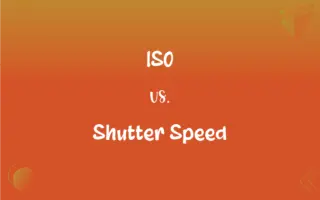Lyophilic Colloids vs. Lyophobic Colloids: What's the Difference?
Edited by Aimie Carlson || By Janet White || Published on February 24, 2024
Lyophilic colloids are solvent-attracting and easily form colloidal solutions, whereas lyophobic colloids repel solvents and are difficult to form into colloids.

Key Differences
Lyophilic colloids are characterized by their affinity towards the solvent, resulting in stable colloidal solutions. Conversely, lyophobic colloids exhibit a tendency to repel the solvent, leading to less stable colloids that often require special methods for preparation.
The stability of lyophilic colloids is due to the strong attraction between the particles and the solvent, making them less prone to coagulation. On the other hand, lyophobic colloids lack this strong interaction, making them more susceptible to aggregation and precipitation.
Lyophilic colloids are typically reversible, meaning they can be easily reconstituted upon addition of the solvent. In contrast, lyophobic colloids are usually irreversible, and their preparation often requires specific conditions like high-energy input or stabilizing agents.
The preparation of lyophilic colloids is generally straightforward, as they spontaneously form when the substance is mixed with the solvent. However, forming lyophobic colloids often involves complex methods like condensation or dispersion techniques.
The viscosity of lyophilic colloidal solutions is usually higher than that of the pure solvent due to strong particle-solvent interactions. In contrast, lyophobic colloids typically have a viscosity closer to that of the pure solvent, as the particles have minimal interaction with it.
ADVERTISEMENT
Comparison Chart
Solvent Affinity
High attraction to solvent
Low or no attraction to solvent
Stability
High stability, resistant to coagulation
Lower stability, prone to coagulation
Reversibility
Usually reversible
Usually irreversible
Preparation
Easy and spontaneous
Complex, requiring specific conditions
Viscosity
Higher than pure solvent
Similar to pure solvent
ADVERTISEMENT
Lyophilic Colloids and Lyophobic Colloids Definitions
Lyophilic Colloids
Lyophilic colloids exhibit high stability because of the significant interaction between the particles and the solvent.
Starch forms a stable lyophilic colloid when mixed with water.
Lyophobic Colloids
Lyophobic colloids are colloidal systems where particles have little to no affinity for the solvent.
Silver nitrate precipitated in water forms a lyophobic colloid.
Lyophilic Colloids
Lyophilic colloids are easily reconstituted upon addition of solvent due to their solvent-loving nature.
A lyophilic colloid like gum arabic can be readily prepared by adding it to water.
Lyophobic Colloids
Lyophobic colloids are often irreversible and require specific conditions for their preparation.
A lyophobic colloid like gold particles in water needs special conditions for formation.
Lyophilic Colloids
Lyophilic colloids often have higher viscosity than the solvent alone.
A solution of agarose in water, a typical lyophilic colloid, is noticeably more viscous than water.
Lyophobic Colloids
Lyophobic colloids have a viscosity similar to that of the pure solvent.
A colloidal solution of ferric hydroxide in water maintains a viscosity close to that of water.
Lyophilic Colloids
Lyophilic colloids are characterized by their reversible nature, allowing easy formation and reformation.
Egg albumin in water is a lyophilic colloid that can be easily prepared and reconstituted.
Lyophobic Colloids
Lyophobic colloids typically require stabilizers or high-energy input for their formation.
Preparing a colloidal dispersion of platinum in water, a lyophobic colloid, often requires ultrasonic agitation.
Lyophilic Colloids
Lyophilic colloids are colloidal systems where particles have a strong affinity for the solvent.
Gelatin dissolved in water forms a lyophilic colloid.
Lyophobic Colloids
Lyophobic colloids exhibit lower stability and are prone to coagulation and precipitation.
A colloidal solution of sulfur in water, a lyophobic colloid, is less stable and easily coagulates.
FAQs
What preparation method is used for lyophilic colloids?
Simple mixing with the solvent is usually sufficient.
What are lyophobic colloids?
Colloidal particles that repel the solvent, resulting in less stable colloids.
What is the viscosity of lyophilic colloidal solutions?
Higher than the pure solvent due to particle-solvent interactions.
Do lyophobic colloids have high viscosity?
No, their viscosity is similar to the pure solvent.
Can lyophilic colloids be easily reconstituted?
Yes, lyophilic colloids can be easily reconstituted by adding solvent.
Are lyophobic colloids common in industrial applications?
Yes, they are often used in paints, inks, and drug delivery systems.
How do lyophilic colloids differ in stability from lyophobic colloids?
Lyophilic colloids are more stable due to strong particle-solvent interactions, whereas lyophobic colloids are less stable.
Are lyophobic colloids reversible?
No, lyophobic colloids are typically irreversible.
What are lyophilic colloids?
Colloidal particles with a strong affinity for the solvent, forming stable solutions.
How are lyophobic colloids prepared?
They require specific conditions like high-energy input or stabilizers.
Can lyophilic colloids coagulate easily?
No, they are resistant to coagulation due to strong affinity with the solvent.
Do lyophobic colloids react to temperature changes?
Yes, they can be sensitive to temperature, affecting their stability.
What is an example of a lyophilic colloid?
Protein solutions, like egg white in water.
Are lyophilic colloids commonly found in nature?
Yes, many biological systems contain lyophilic colloids.
What happens when salt is added to a lyophilic colloid?
Generally, little to no effect, as lyophilic colloids are quite stable.
What is the effect of adding salt to a lyophobic colloid?
It can lead to coagulation or precipitation of the colloid.
Can temperature changes affect lyophilic colloids?
Lyophilic colloids are usually less sensitive to temperature changes.
Are lyophobic colloids prone to coagulation?
Yes, due to their low affinity with the solvent.
Are lyophilic colloids used in medical applications?
Yes, they are used in drug formulations and diagnostic imaging.
Can you give an example of a lyophobic colloid?
Suspensions of metals like silver or gold in water.
About Author
Written by
Janet WhiteJanet White has been an esteemed writer and blogger for Difference Wiki. Holding a Master's degree in Science and Medical Journalism from the prestigious Boston University, she has consistently demonstrated her expertise and passion for her field. When she's not immersed in her work, Janet relishes her time exercising, delving into a good book, and cherishing moments with friends and family.
Edited by
Aimie CarlsonAimie Carlson, holding a master's degree in English literature, is a fervent English language enthusiast. She lends her writing talents to Difference Wiki, a prominent website that specializes in comparisons, offering readers insightful analyses that both captivate and inform.






































































